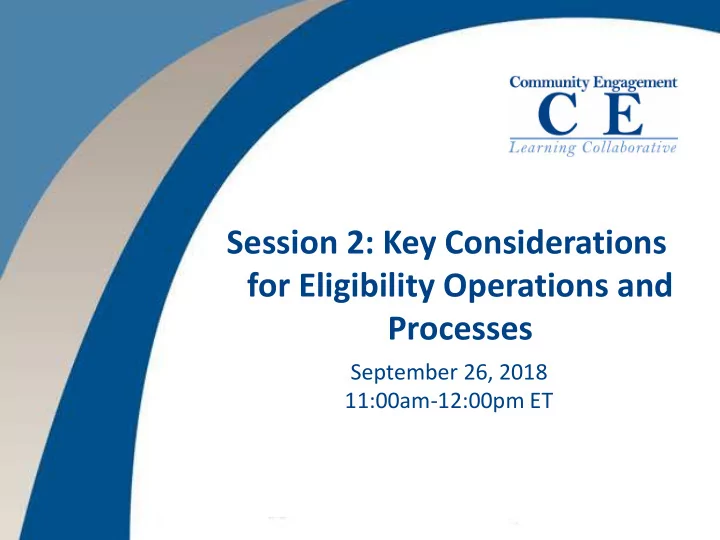

Session 2: Key Considerations for Eligibility Operations and Processes September 26, 2018 11:00am-12:00pm ET
2 Key Considerations for Eligibility Operations and Processes
Implementation Planning Steps 3 Define community engagement policies 1 – Eligible/exempt populations – Qualifying activities and hours Identify beneficiary supports and provide reasonable 2 modifications – Connections to available qualifying activities – Tools and resources to help beneficiaries participate Track beneficiary compliance 3 – Expectations for beneficiary reporting – Back-end verification processes Develop strategies for non-compliance 4 – Suspension/termination, reinstatement, grace periods Establish continuous monitoring 5 – Assessment of policies and processes and refinement, as needed
3 Key Focus Areas 4 The plan for each implementation step will need to address these areas: Area Examples of Activities • • Develop SOPs Assess staffing needs • • Operational Identify resources Create training materials • Changes Establish partnerships • Modify contracts • • Develop new functionality Create new portals • • System Maintain successful Set system flags • capabilities Build interfaces Capabilities • Strategies for: • Create notices Communication o Beneficiaries • Develop web content o Stakeholders Strategy • Establish a social media plan o Agency staff
1 Define Community Engagement Policies 5 Examples of Work to be Done: • Develop new SOPs and training materials for eligibility staff on qualifying activities, exemptions, compliance requirements • Operational Revise application and enrollment processes to incorporate Changes community engagement eligibility requirements • Assess staffing needs for all components of the work – eligibility, systems, project management, stakeholder engagement, etc. • Assess needed systems modifications and new functionality to be System developed • Develop concept of operations Capabilities • Identify needs for new contracts and vendors • Develop a communications plan for facilitating change management with agency staff • Develop communication plan for beneficiaries that addresses the Communication new requirements and their responsibilities - notices, PSAs, social Strategy media, etc. • Establish communication strategies to recruit partners and stakeholders
Beneficiary Supports and Reasonable 2 Modifications 6 Examples of Work to be Done: • Modify call center contracts to add new requirements/ functionality or connecting beneficiaries to tools and resources Operational • Develop new partnerships with other agencies such as state Changes departments of labor, transportation, and education; volunteer organizations; child care providers • Establish interfaces with agencies providing supports • Perform data analytics to identify and flag exempt beneficiaries System • Develop tracking tools for those needing reasonable modifications Capabilities • Develop partnerships and engage volunteer groups, employers, educators, training entities, public libraries, etc. Communication • Provide ongoing information and guidance to stakeholders who can Strategy provide supports to particular populations
3 Tracking Compliance 7 Examples of Work to be Done: • Establish data sharing agreements with other human services Operational programs to track participation in SNAP/TANF programs Changes • Consider special units dedicated to tracking compliance • Build interfaces with available data sources to check compliance. Identify and tag beneficiaries in the system who must comply, who are exempt, etc. • Develop new interfaces for beneficiary reporting, including System functionality for uploading documentation, if needed Capabilities • Modify consumer and worker portals to assist eligibility staff and beneficiaries in understanding compliance status • Develop functionality to identify beneficiaries who are not meeting requirements and may need reminders or help • Create notices to clearly define the expectations for beneficiary reporting at each step in the process Communication • Expand partnerships with MCOs and other stakeholders providing Strategy support to beneficiaries in meeting requirements
4 Develop Strategies for Non-Compliance 8 Examples of Work to be Done: • Establish clear pathways for beneficiaries to be reinstated after suspension or re-enrolled after termination Operational • Ensure that penalties do not have a negative impact on other Changes household members who are not subject to the demonstration • Develop system capabilities to function dynamically with on- ramp activities, lift sanctions timely, monitor suspensions to stop System or start capitation payments Capabilities • Expand data analytics and reporting functionality to monitor beneficiaries once suspended or terminated • Notify beneficiaries of changes in eligibility, and build in time to provide advanced notice of adverse action Communication • Develop materials and outreach strategies to help beneficiaries Strategy and stakeholders understand requirements for reinstatement, as necessary
5 Establish Continuous Monitoring 9 Examples of Work to be Done: • Establish monitoring plan including metrics • Operational Conduct regular data analysis to identify success and problems • Changes Establish processes for refining SOPs and training materials in response to newly identified issues • Build functionality to track and report metrics. • System Develop data analytics and refine systems to capture the data Capabilities that you can refine your own monitoring and what to report to CMS. Data warehouse supports, etc. • Obtain regular stakeholder input (eg. from community organizations, state staff, and workforce partners) on policies Communication and processes • Strategy Survey beneficiaries to gauge understanding of policies and consequences of non-compliance • Develop strategies for communicating revisions to processes
10 Thank you! To ask questions and provide feedback, contact CELC@mathematica-mpr.com
Recommend
More recommend